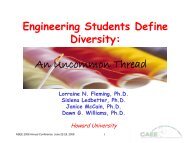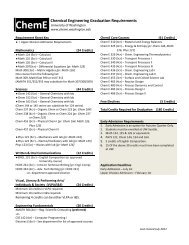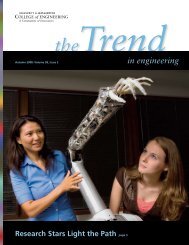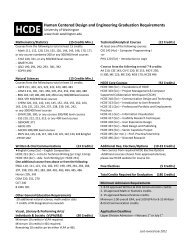presentation slides - College of Engineering
presentation slides - College of Engineering
presentation slides - College of Engineering
Create successful ePaper yourself
Turn your PDF publications into a flip-book with our unique Google optimized e-Paper software.
The Role <strong>of</strong> ‘Doggedness’ in the Completion<strong>of</strong> an Undergraduate Degree in <strong>Engineering</strong>Janice McCain, Ph.D.*Lorraine Fleming, Ph.D.Dawn Williams, Ph.D.Kimarie Engerman, Ph.D.Howard UniversityPresented at the ASEE Annual Conference and ExpositionHonolulu, HawaiiJune 27, 2007
Background• APS Data Collected from Four Institutions:• Public/ Private• Research/ Technical Orientation• Size <strong>of</strong> Student Population• Ratio <strong>of</strong> Male to Female Students
Introduction• Research over the past 15 years has shown that the interestin pursuing undergraduate degrees in engineering hasdeclined.• Research focuses on factors used to predict the likelihoodthat a student will successfully complete an undergraduatedegree in engineering.• There is a lack <strong>of</strong> research and discussion pertaining to thesignificance <strong>of</strong> characteristics that can be described as‘doggedness’.
Methodology• Subset <strong>of</strong> the larger APS sample used to assess levels <strong>of</strong>commitment, persistence, and satisfaction• Second year study participants were asked open andclosed-ended questions• Data from structured interviews were analyzedqualitatively• A ‘within case’ analysis was used to provide a snapshot <strong>of</strong>characteristics that demonstrate doggedness in the sample
What is Doggedness?• Doggedness entails perseverance, tenacity, and theability to stubbornly adhere to a course <strong>of</strong> action.• It holds the potential promise <strong>of</strong> pointing to avaluable personality attribute or characteristic thatsupports greater levels <strong>of</strong> persistence inengineering students.
How Doggedness wasDetermined• Primary evidence for doggedness was revealed bystudent responses in two areas:– level <strong>of</strong> commitment– persistence• Enjoyment and satisfaction were used assecondary measures for doggedness to assesswhether or not they are important factors, and todetermine the range <strong>of</strong> responses for persisters.
How committed are you topursuing an engineering major?YEAR 12004YEAR 22005YEAR 32006Freq%Freq%Freq%Very Committed2745.04981.65286.7Somewhat Committed2745.0813.3610.0Not Very Committed23.300.023.3Not Committed11.711.700.0Invalid Response23.311.700.0No Response00.011.700.0Don’t Know11.700.000.0n = 60100%n = 60100%n = 60100%
How committed are you topursuing an engineering major?And why?• Students displayed a range <strong>of</strong> responses to “why”they selected a particular level <strong>of</strong> commitment• The intensity <strong>of</strong> their persistence stood out• Examples <strong>of</strong> student responses include:“I've gone too far to turn back now'; “I've put in alot <strong>of</strong> work and there's no reason to back outwhatsoever right now”; and “I'm in too deep toleave and, even though its very hard right now, Ithink it will pay <strong>of</strong>f in the end”
Three types <strong>of</strong> 'dogged''students• Unyielding Persister• Intense Goal Setter• Economic Rationalizer
Unyielding Persister• Brian, a male petroleum engineering major:During his second year, he indicated that he wasvery committed to getting a degree in engineering.He pointed to the number <strong>of</strong> times that he had toretake some <strong>of</strong> his courses, and his insistence that“I will stay here as many years as I have to, to getmy petroleum degree”, as testimony to hispersistence. In the end, he declared, “if I wasn’tcommitted then I wouldn’t be here”.
Economic Rationalizers• Philip, a male management science and engineering major, said thatthere was “a practical reason for being very committed to completingthe major in engineering”. If he were to change majors, he predictedthat he “would be in school for another four years”. In addition, hesaid that he really enjoyed his classes related to engineering, andpredicts that he will enjoy the companies that he plans to work for inthe future.• Steven, a male mechanical engineering major. Steven allowed time toexplore courses in political science, philosophy, and history in themidst <strong>of</strong> a very demanding engineering program. Engaging in othersubjects allowed him to determine that he “would never want to dothose majors” and stated that “at this point in my school career, I’mnot changing majors [because] my parents are not going to pay for afifth year in college and I wouldn’t finish anything at that pointanyhow”. He concluded by adding, “when I looked at all the differentmajors I could possibly pursue at school, engineering was the only onethat really appealed to me”.
Enjoyment and Satisfaction• During the structured interview,students were asked, “Are there anyaspects <strong>of</strong> engineering that youparticularly like?” and “Are there anyaspects <strong>of</strong> engineering that youparticularly dislike?”• Questions probed specific features <strong>of</strong>engineering programs that studentsexperience.
ResponsesLikes: A greater frequency <strong>of</strong> students stated theyliked their engagement in problem solving and thedesign aspects <strong>of</strong> their courseworkDislikes: The quantity <strong>of</strong> work, associated stress, andthe considerable amount <strong>of</strong> time required to carryout class assignmentsThe subset <strong>of</strong> very committed and persistent students,when reviewing level <strong>of</strong> program enjoyment, left afairly unchanged group <strong>of</strong> respondents called'dogged'.
Future Plans <strong>of</strong> Dogged<strong>Engineering</strong> StudentsPlansShort Term PlanLong Term PlanWork in <strong>Engineering</strong>Graduate School in <strong>Engineering</strong>UncertainTravel/ Take Time Off<strong>Engineering</strong> ManagementWork in Non-<strong>Engineering</strong>%45.222.612.911.36.54.8%17.18.10.00.03.21.6
FINDINGS• A small but identifiable group <strong>of</strong> dogged engineering students wasfound in the structured interview segment <strong>of</strong> the study• High levels <strong>of</strong> commitment, persistence, and satisfaction are conveyedacross the spectrum <strong>of</strong> engineering majors• Doggedness is a characteristic that develops and increases with time• Students identified as dogged exhibited varying levels <strong>of</strong> enjoymentand satisfaction. Students that primarily enjoyed experiencesassociated with pursuing their engineering degrees were more intent onworking in the engineering industry
Conclusion• Continued effort needs to be made to promotegraduate education among engineering degreerecipients• To increase the number <strong>of</strong> engineering studentsentering graduate school, undergraduate programcoordinators need to address some <strong>of</strong> the aspects<strong>of</strong> the program that students dislike.
References• 1. French, B.F., J.C. Immekus and W.C. Oakes (2005). An Examination <strong>of</strong>Indicators <strong>of</strong> <strong>Engineering</strong> Students’ Success and Persistence. Journal <strong>of</strong> <strong>Engineering</strong>Education, October 2005; 94, 4, pp. 419-425.• 2. Swail, W. S. (with Redd, K. E. and Perna, L. W.). (2003). Retaining MinorityStudents in Higher Education: A Framework for Success. ASHE-ERIC HigherEducation Report No. 2. Washington, DC: The George Washington University,School <strong>of</strong> Education and Human Development.• 3. National Postsecondary Education Cooperative. (2006). What matters tostudent success: A review <strong>of</strong> the literature. Commissioned report for the NationalSymposium on Post Secondary Student Success: Spearheading a dialogue on studentsuccess.• 4. Tinto, V. (1993). Leaving <strong>College</strong>: Rethinking the Causes and Cures <strong>of</strong>Student Attrition. Chicago: The University <strong>of</strong> Chicago Press.• 5. National Center for Education Statistics. (2000). Entry and Persistence <strong>of</strong>Women and Minorities in <strong>College</strong> Science and <strong>Engineering</strong> Education. U.S.Department <strong>of</strong> Education.• 6. Deci, E.L. and R.M. Ryan. (1985). Intrinsic Motivation and Self-Determinationin Human Behavior. New York: Plenum.• 7. Eccles, J. S. and A. Wigfield. (2002). Motivational Beliefs, Values, and Goals.Annual Review <strong>of</strong> Psychology; 2002; 53, Research Library, pp. 109-132.• 8. Seymour, E. and N. Hewitt. (1997). Talking About Leaving: WhyUndergraduates Leave the Sciences. Westview Press, Colorado.
Acknowledgements• This material is based on work supported by theNational Science Foundation under Grant No.ESI-0227558, which funds the Center for theAdvancement <strong>of</strong> <strong>Engineering</strong> Education (CAEE).• We would also like to acknowledge the researchcontributions <strong>of</strong> Dr. Karen Bland, Andrene Taylor,M.A., and our undergraduate research assistants.
















